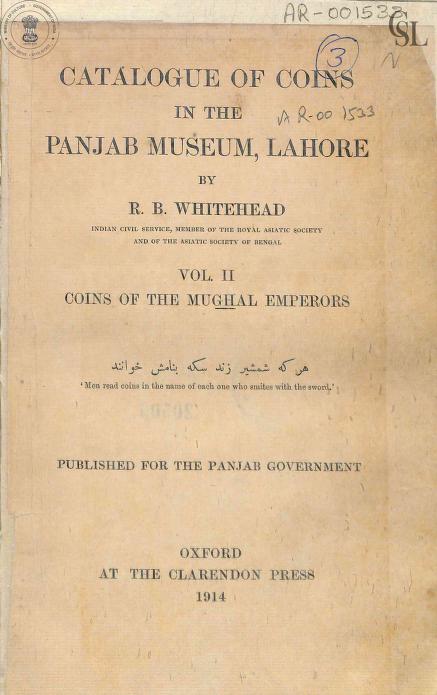Catalogue of The Coins in The Panjab Museum Lahore Vol II

About
Summary
Exquisite
TOC
Details
Related
URL
Images
Overview
Catalogue of the Coins in the Panjab Museum, Lahore, Vol. II: Coins of the Mughal Emperors by R.B. Whitehead is a detailed numismatic catalogue focusing on coins from the Mughal Empire housed in the Panjab Museum. The book is a significant resource for numismatists, historians, and scholars interested in the economic, political, and cultural history of the Mughal period in India.
Importance of Book
Comprehensive Catalogue: The book provides a detailed and organized catalogue of Mughal coins, making it an essential reference for identifying and studying these coins.
Numismatic Standard: Whitehead's catalogue numbering system has been widely adopted by collectors, coin dealers, and scholars for describing and referencing coins of the Delhi Sultanate.
Rarity Assessment: The book offers carefully considered assessments of the relative commonness or rarity of each coin type, which is valuable for researchers in calculating coin populations and understanding the survival rates of medieval coins.
Historical Insights: By studying the coinage, the book sheds light on the economic conditions, political events, and cultural influences of the Mughal Empire.
Foundation for Research: The catalogue serves as a foundation for further research into the monetary history of the Mughal period and its impact on the broader socio-economic landscape.
Key Themes
Monetary History: The book explores the monetary system of the Mughal Empire through its coinage, including coin denominations, metal content, and minting processes.
Economic Conditions: The coins reflect the economic prosperity, trade networks, and financial policies of the Mughal rulers.
Political Authority: Coinage was used by the Mughal emperors to assert their sovereignty, display their symbols of power, and legitimize their rule.
Cultural Symbols: The motifs, inscriptions, and artistic styles on the coins provide insights into the cultural and religious beliefs of the time.
Numismatic Analysis: The book employs numismatic analysis to classify, date, and interpret the coins, contributing to a deeper understanding of Mughal history.
Cultural Significance
Reflection of Mughal Culture: The coins showcase the artistic and cultural achievements of the Mughal Empire, including calligraphy, ornamentation, and portraiture.
Religious Influences: The inscriptions and symbols on the coins reflect the religious beliefs and practices of the Mughal rulers and their subjects.
Cross-Cultural Interactions: The coins demonstrate the exchange of ideas, technologies, and artistic styles between the Mughal Empire and other regions.
Historical Memory: The coins serve as tangible reminders of the Mughal era, preserving its legacy and cultural heritage for future generations.
Artistic Value: The coins are not only historical artifacts but also works of art, appreciated for their aesthetic beauty and craftsmanship.
Effects on Society
Economic Impact: The Mughal coinage played a crucial role in facilitating trade, commerce, and economic growth in the empire.
Political Influence: The standardization of coinage under the Mughals helped to consolidate their rule and promote economic integration.
Social Stratification: The availability and distribution of coins reflected the social hierarchy and economic disparities within Mughal society.
Cultural Identity: The coinage contributed to the development of a shared cultural identity among the diverse populations of the Mughal Empire.
Historical Awareness: The study of Mughal coins has increased awareness and appreciation of the country's rich historical and cultural heritage.
Conclusion
Catalogue of the Coins in the Panjab Museum, Lahore, Vol. II by R.B. Whitehead is an essential resource for understanding the monetary history, economic conditions, political authority, and cultural significance of the Mughal Empire. The book has had a lasting impact on numismatic studies and has contributed to a greater appreciation of India's rich cultural heritage.
Table of Content
The 1914 edition of Catalogue of the Coins in the Punjab Museum Lahore, Volume II, by R.B. Whitehead, is a detailed catalog focusing on the collection of coins housed in the Punjab Museum in Lahore. Here is a brief overview of the table of contents for this volume:Table of Contents
IntroductionAn overview of the coin collection and the methodology used for cataloging.
Context about the Punjab Museum and its significance in preserving numismatic heritage.
Catalogue of CoinsSection I: Ancient Coins
Detailed descriptions of ancient coins from various periods, including those from the Mauryan, Indo-Greek, and Kushan empires.
Section II: Medieval Coins
Information on coins from the medieval period, including those from the Delhi Sultanate and Mughal Empire.
Section III: Mughal Coins
Comprehensive listings of Mughal coins, including detailed information on emperors, minting techniques, and inscriptions.
AppendicesAdditional notes and supplementary information relevant to the coin collection.
Corrections or updates to the catalog entries, if any.
Title
Catalogue of The Coins in The Panjab Museum Lahore Vol II
Author
R B Whitehead
Name of Publisher
Oxford at The Clarendon press
Publish Date
1914
Subject
A detailed catalog focusing on the collection of coins
Vintage
1901-1947
Category
India
Sub Category
Coins / stamps
Rarity
RARE
